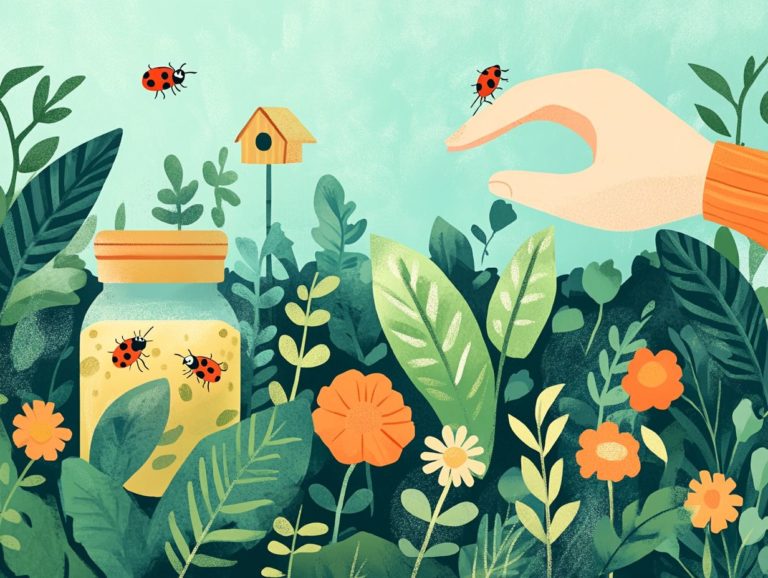Using Hand Pollination to Reduce Pest Issues
Hand pollination is an essential gardening method that can greatly enhance your gardening success. Whether you aim to improve your plant yield or address pest issues, grasping the basics of hand pollination can truly make a difference. This article delves into what hand pollination is, its benefits, and the optimal times and methods for carrying it out effectively.
You’ll also find valuable tools and techniques to aid your efforts, troubleshoot common challenges, and discover complementary pest control methods. Prepare to elevate your gardening game to new heights!
Contents
- Key Takeaways:
- The Basics of Hand Pollination
- Benefits of Hand Pollination
- When and How to Hand Pollinate
- Tools and Techniques for Hand Pollination
- Troubleshooting Common Issues
- Other Natural Pest Control Methods
- Frequently Asked Questions
- What is hand pollination?
- How does hand pollination reduce pest issues?
- When is the best time to use hand pollination to reduce pest issues?
- Can hand pollination be used in all types of plants?
- What are the steps to hand pollination?
- Are there any precautions to take when using hand pollination to reduce pest issues?
Key Takeaways:

- Hand pollination effectively reduces pest issues in plants and improves pollinator protection.
- By hand pollinating, you can increase the yield and quality of your crop.
- Knowing the right time and method for hand pollination, as well as having the right tools and techniques, can greatly improve its success rate.
The Basics of Hand Pollination
Hand pollination is a crucial gardening method that helps ensure the reproduction of diverse food crops, particularly in light of declining pollinator populations. By manually transferring pollen from the male to the female parts of flowers, you can effectively address the diminishing natural pollination services that many ecosystems depend upon.
This practice also supports sustainable farming initiatives and enhances agricultural systems through integrated pest management, a way to control pests while keeping the environment healthy, by improving both crop yield and quality. This is especially important in areas significantly impacted by biodiversity loss.
What is Hand Pollination?
Hand pollination is the intentional transfer of pollen from one flower to another. This practice boosts fruit set and overall yield, primarily in agriculture.
This method becomes especially vital in commercial farming, where natural pollination might fall short of meeting increasing crop demands. For example, during inclement weather or in areas with a scarcity of pollinators like bees, farmers turn to hand pollination to guarantee their plants receive sufficient pollen.
Using tools such as paintbrushes or small air-filled syringes, they meticulously collect pollen and apply it to the stigma of receptive flowers. This careful technique heightens the chances of successful fertilization and significantly enhances the quality and quantity of the fruits produced. Thus, hand pollination emerges as an essential strategy for achieving crop success.
Benefits of Hand Pollination
You ll discover many advantages with hand pollination. It minimizes pest-related problems and enhances both the yield and quality of your food crops. These benefits are crucial for fostering sustainable agricultural practices that support long-term productivity and environmental health.
Reducing Pest Issues
Hand pollination can lead to healthier plants that are less vulnerable to pests like the western conifer seed bug and brown marmorated stink bug, significantly cutting back on chemical interventions.
When you implement this method effectively, you’ll notice an enhancement in fruit quality and yield, resulting in more vigorous plants capable of naturally repelling infestations. As these stronger plants thrive, they develop robust defenses that minimize their susceptibility to various pests.
In an integrated pest management (IPM) approach, the emphasis shifts from heavy reliance on pesticides to cultivating environments that support healthier crops. This fosters sustainable agricultural practices and promotes ecological balance, allowing beneficial insects to thrive while reducing pest populations.
Thus, hand pollination stands out as a crucial strategy for ensuring both plant health and effective pest control through natural pollination methods. Start using hand pollination today to boost your garden s health and productivity!
Increasing Yield and Quality

Hand pollination can significantly boost both the yield and quality of your food crops. This method gives you access to more robust and marketable products.
By ensuring efficient pollen transfer, hand pollination enhances fruit set. This minimizes poor pollination and elevates the overall harvest.
When you nurture your plants through this technique, you re increasing quantity and enhancing market appeal. Well-pollinated crops typically have improved size, flavor, and shelf life.
Integrating this method into your sustainable farming practices allows you to reduce reliance on chemical inputs while promoting a healthier ecosystem. Crops that benefit from hand pollination often stand out as premium items, commanding higher prices in the marketplace and positively impacting local economies.
When and How to Hand Pollinate
Understanding when and how to hand pollinate is essential for optimizing the effectiveness of this technique. Keep a close eye on your plants to catch the perfect moment for pollination!
This process requires keen observation of flowering times and environmental conditions, such as watering habits and soil tests.
Identifying the Right Time and Method
Identifying the right moment for hand pollination is crucial for successful fertilization in agricultural production. Look for various visual cues during the blooming stage of flowers, when petals are fully open and exhibit optimal receptivity.
Understanding the surrounding environmental conditions is equally vital. Factors like temperature, humidity, and wind can significantly impact pollination effectiveness. For example, warmer temperatures encourage more active pollinators.
By continuously monitoring these indicators, you can strategically determine the perfect time for hand pollination, maximizing your yield and promoting healthier crops.
Tools and Techniques for Hand Pollination
Successful hand pollination demands the right tools and techniques for effective pollen transfer. This significantly enhances natural pollination outcomes in your food crops.
By mastering these methods, you can ensure a more fruitful harvest and contribute to the overall health of your garden.
Choosing the Right Tools
Choosing the right tools for hand pollination is crucial for effective pollen transfer and promoting sustainable farming practices that support the health of native plants.
Farmers often utilize a range of tools to streamline this process. For instance, brushes enable precise application of pollen onto flowers, while small suction devices facilitate pollen transfer without harming delicate blooms.
By opting for these tools, you can reduce reliance on chemical interventions, making your farming practices more eco-friendly. Embracing these strategies boosts your crop yields while supporting the overall health of the ecosystem, fostering biodiversity and resilience in your agricultural systems.
Step-by-Step Guide to Hand Pollination

Ready to take your gardening to the next level? Hand pollination can ensure your plants thrive! A step-by-step guide to hand pollination encompasses specific techniques designed to enhance pollinator protection and promote the success of your crops. By understanding the details of this process, you can ensure your plants reach their full potential.
First, it’s essential to select the right moment for pollination. Early morning or late afternoon typically offers the best results, as flowers tend to be more receptive during these hours.
Using a soft brush or cotton swab, gently collect pollen from the male flower, taking care not to damage the delicate petals. Next, transfer this pollen to the stigma of the female flower with a gentle touch to avoid causing harm.
Maintaining optimal moisture levels and ensuring your plants receive adequate sunlight can further increase the chances of successful fertilization. This ultimately leads to a bountiful harvest.
Troubleshooting Common Issues
Troubleshooting common issues with hand pollination is crucial for ensuring effective pollen transfer. By addressing these challenges, you can minimize the impact of any obstacles, including the necessity to tolerate visible damage to your plants.
Tips for Dealing with Pollination Challenges
Addressing pollination challenges calls for practical tips that can elevate the effectiveness of hand pollination in agricultural production. Ultimately, this contributes to the success of your agricultural systems.
As a farmer or gardener, understanding the unique needs of your pollination systems is invaluable. Timing plays a pivotal role; pollinating during early morning or late afternoon, when flowers are at their most receptive, can substantially boost your success rates.
Leveraging tools like soft brushes or cotton swabs can efficiently transfer pollen from one bloom to another. It s equally important to cultivate a supportive environment by ensuring adequate moisture and minimizing chemical use since these factors greatly influence the health of your pollinators.
Act now to boost your crop yields! By integrating these strategies, you can navigate the complexities of pollination with newfound confidence.
Other Natural Pest Control Methods
Many natural pest control methods are also crucial for effective pest management. These approaches emphasize integrated pest management, a combination of different methods to control pests effectively, while aiming at protecting pollinators and ensuring a balanced ecosystem.
Complementary Strategies for Pest Management
Complementary strategies for pest management include integrated pest management techniques that seamlessly blend the use of native plants and sustainable farming practices.
These approaches not only enhance biodiversity but also promote natural pest control methods, which are essential for maintaining healthy ecosystems. By integrating beneficial insects into your agricultural practices, you can cultivate a balanced environment where pollinators and natural predators coexist harmoniously, effectively managing pest populations.
Implementing crop rotation and introducing cover crops further strengthens this strategy, disrupting pest cycles while enriching the soil. This holistic perspective on farming safeguards your crops and aligns with sustainable practices that prioritize long-term environmental health and agricultural resilience.
Frequently Asked Questions

What is hand pollination?
Hand pollination is the process of manually transferring pollen from the male reproductive organ (the stamen) of a plant to the female reproductive organ (the pistil) to facilitate fertilization and reproduction.
How does hand pollination reduce pest issues?
Hand pollination helps to increase the genetic diversity of plants, making them more resistant to pests and diseases. It also produces healthier and more resilient plants, making them less susceptible to pest attacks.
When is the best time to use hand pollination to reduce pest issues?
The best time for hand pollination is in the early stages of plant growth. This timing helps prevent significant pest damage.
Hand pollination is also effective after a pest infestation. It helps plants recover and grow stronger.
Can hand pollination be used in all types of plants?
Absolutely! Hand pollination works wonders on many types of plants, including fruits, vegetables, and flowers.
It’s especially useful for plants with low pollination rates or those vulnerable to pests.
What are the steps to hand pollination?
First, identify the parts of the plant that make seeds. Then, use a small brush or cotton swab to gently transfer pollen from the male part to the female part.
Repeat this process for each flower or plant that needs hand pollination.
Are there any precautions to take when using hand pollination to reduce pest issues?
Ensure your tools for hand pollination are clean and free of pesticides or chemicals. Be careful not to damage the flowers, as this could attract pests and hinder pollination success.






